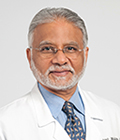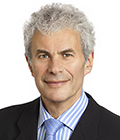In celebration of the American Thoracic Society’s 110th anniversary, the ATS International Conference will feature seminal clinical and scientific breakthroughs in the Discoveries Series. The series encompasses eight lectures by internationally recognized speakers who have contributed to major discoveries in pulmonary, critical care, and sleep medicine.
“With input from our members, these special lectures will highlight major scientific and clinical breakthroughs in our fields and celebrate how these advances have improved patient lives,” says ATS President Thomas Ferkol, MD. “The lectures will not only look back but also forward to the opportunities these discoveries hold.”
Two lectures will be given concurrently from 8:30 to 9:15 a.m. today, Monday, Tuesday, and Wednesday. These lectures will be unopposed by other programming. Here is what is scheduled today.
“Past, Present and Future of Bronchoscopy”
Four Seasons Ballroom 1-2 (Lower Level) Colorado Convention Center

Atul Mehta
Atul Mehta, MBBS, vice chairman of pulmonary, allergy, and critical care medicine at the Cleveland Clinic, will discuss flexible bronchoscopy, the use of which has grown dramatically in the past two decades. Not only has flexible bronchoscopy become the most common pulmonary diagnostic procedure, it is now used in nearly every aspect of pulmonary medicine.
“There are few pulmonary ailments that a flexible bronchoscope cannot diagnose, treat, or palliate,” says Mehta, adding that one of the most impressive advances in surgery—lung transplantation—would be impossible without bronchoscopy.
Allowing the medical team to diagnose acute organ rejection without an open procedure, bronchoscopy is essential for the success of a lung transplant program. Bronchoscopy also aids in the healing process. In a procedure Dr. Mehta pioneered, bronchoscopists now regularly deploy metallic stents at the site of bronchial dehiscence, reducing mortality from the most feared complication of lung transplantation.
“Past, Present and Future of Bronchoscopy” is supported by an educational grant from Olympus Corporation of the Americas.
“Mechanical Ventilation: From Vesalius to Ventilator-Induced Lung Injury”
Bellco Theatre Section 2 (Street Level) Colorado Convention Center

Arthur S. Slutsky
Arthur S. Slutsky, MD, vice president of research at St. Michael’s Hospital in Toronto, wrote in the New England Journal of Medicine in 2013 that “whereas previously the goals of mechanical ventilation were to maintain gas exchange while minimizing the work of breathing, an additional goal has been established: to provide gas exchange that sustains life while minimizing ventilator-induced lung injury.”
To reduce ventilator-induced lung injury (VILI), Dr. Slutsky believes that researchers and clinicians should look beyond the biophysical trauma that mechanical ventilation can cause to the biochemical trauma it may set in motion. The former is a well-known complication; the latter is more subtle and an area of molecular research that his laboratory has pioneered.
In animal studies, Dr. Slutsky demonstrated that an injurious ventilation strategy can lead to the release of inflammatory mediators, including cytokines, which enter the blood stream and induce cell death in organs beyond the lungs. In a clinical study, Dr. Slutsky measured cytokine concentrations in patients with a conventional mechanical ventilation strategy and those whose strategy was shifted from the conventional to one that provided minimal stress. Shortly after the change, those in the minimal stress group produced less cytokines.
These findings, he believes, may explain why most patients with acute respiratory distress syndrome, all of whom need mechanical ventilation, die of something other than hypoxia.
Learn more about these findings and future directions during the Discoveries Series.
